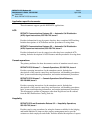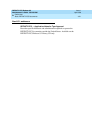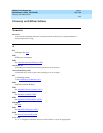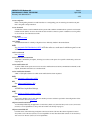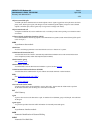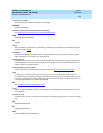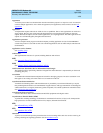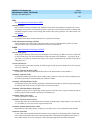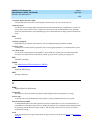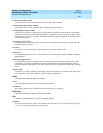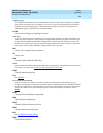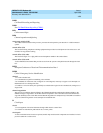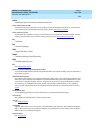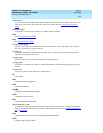
DEFINITY ECS Release 8.2
Administrator’s Guide
555-233-506
Issue 1
April 2000
Glossary and abbreviations
1618
Automatic Route Selection (ARS)
A feature that allows the system to automatically choose the least-cost way to send a toll call.
automatic trunk
A trunk that does not require addressing information because the destination is predetermined. A request for
service on the trunk, called a seizure, is sufficient to route the call. The normal destination of an automatic
trunk is the communications-system attendant group. Also called automatic incoming trunk and automatic tie
trunk.
AUX
Auxiliary
auxiliary equipment
Equipment used for optional system features, such as Loudspeaker Paging and Music-on-Hold.
auxiliary trunk
A trunk used to connect auxiliary equipment, such as radio-paging equipment, to a communications system.
Aux-Work mode
A work mode in which agents are unavailable to receive ACD calls. Agents enter Aux-Work mode when
involved in non-ACD activities such as taking a break, going to lunch, or placing an outgoing call.
AVD
Alternate voice/data
AWOH
See Administration Without Hardware (AWOH).
AWG
American Wire Gauge
AWT
Average work time
B
B8ZS
Bipolar Eight Zero Substitution.
bandwidth
The difference, expressed in hertz, between the defined highest and lowest frequencies in a range.
barrier code
A security code used with the Remote Access feature to prevent unauthorized access to the system.
Basic Rate Interface (BRI)
A standard ISDN frame format that specifies the protocol used between two or more communications sys-
tems. BRI runs at 192 Mbps and provides two 64-kbps B-channels (voice and data) and one 16-kbps D-chan-
nel (signaling). The D-channel connects, monitors, and disconnects all calls. It also can carry low-speed
packet data at 9.6 kbps.
baud
A unit of transmission rate equal to the number of signal events per second. See also bit rate
and bits per sec-
ond (bps).



